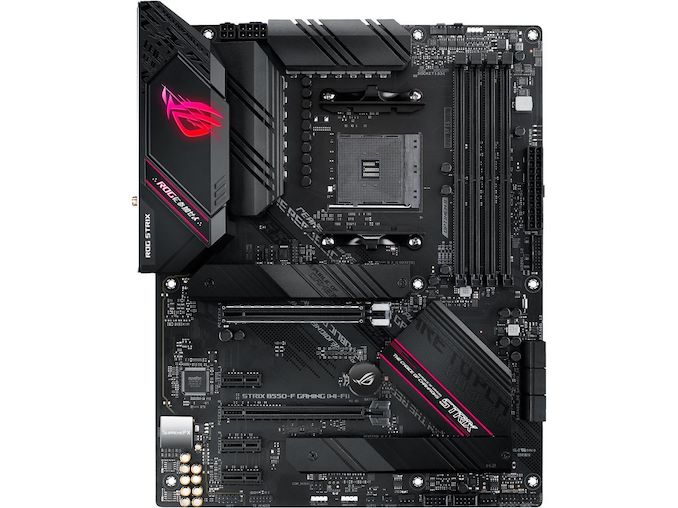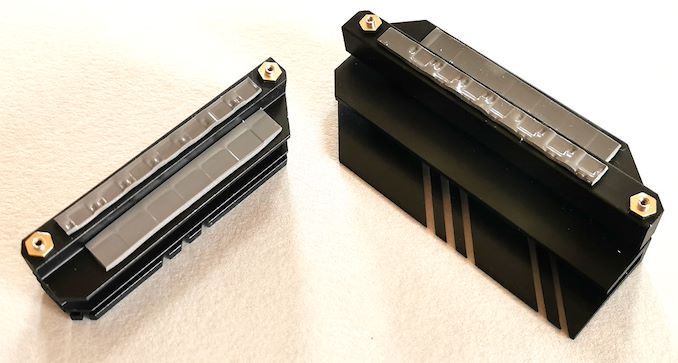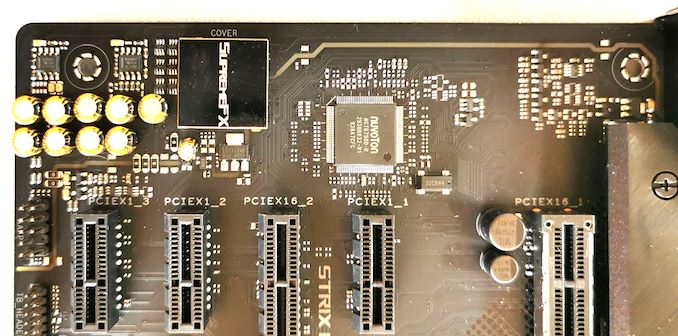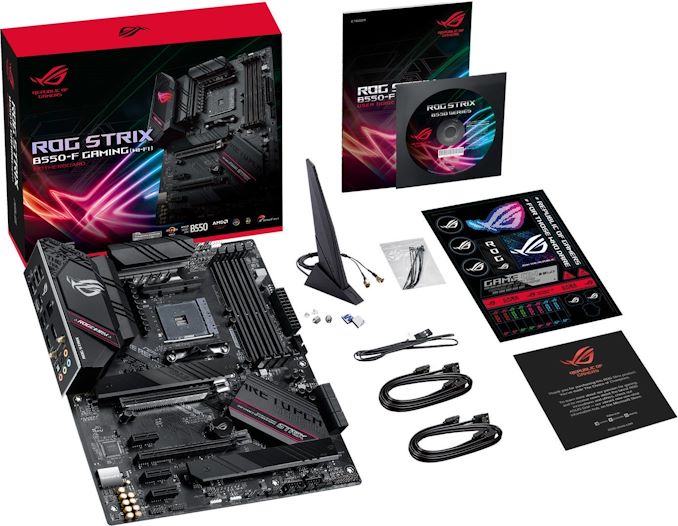The ASUS ROG Strix B550-F Gaming Wi-Fi Motherboard Review: Premium Value
by Gavin Bonshor on July 22, 2020 9:00 AM EST- Posted in
- Motherboards
- AMD
- Asus
- ROG
- AM4
- Strix
- Ryzen 3000
- Ryzen 3700X
- B550
- B550-F
Visual Inspection
The ASUS ROG Strix B550-F Gaming Wi-Fi follows a very flamboyant design with pink highlights on both the rear panel cover and chipset heatsink. The rest of the board follows a black conventional ROG design with diagonal printing on the PCB with Republic of Gamers branding throughout. It blends in from the top of the rear panel cover, all across the PCB and opts for a graffiti-inspired uniformed look. In addition to the illuminated and RGB enabled ROG logo is a pair of Aura RGB headers, with a single addressable RGB header which allows users to add a bit of pizazz to the already unconventional styling.
Focusing on the PCIe, the Strix B550-F Gaming Wifi includes a full-length PCIe 4.0 x16 slot located at the top with metal PCIe slot fortification, with three PCIe 3.0 x1 slots and a full-length PCIe 3.0 x4 slot also present. Flanking both of the full-length PCIe slots is a pair of M.2 slots, both with M.2 heatsinks, with the top slot offering support for up to PCIe 4.0 x4, and the bottom with support for up to PCIe 3.0 x4. Both the top full-length PCIe 4.0 x16 and top PCIe 4.0 x4 M.2 slot require an AMD Ryzen 3000 series processor to fully utilise this, with anything else installed will force the slots to operate at PCIe 3.0. There are also six SATA ports which provide support for RAID 0, 1, and 10 arrays.
In the top right-hand corner is four memory slots with support for DDR4-5100, and a total capacity of up to 128 GB. Located around the edge of the board are six 4-pin headers with two for a CPU fan, one for an AIO pump, and three for regular chassis fans.
ASUS has opted to used teamed power stages for its power delivery, which ASUS claims improve transient response and efficiency, as well as overall power response when under full-load. The B550-F Gaming Wi-Fi is using a 14-phase design, with twelve teamed Vishay SIC639 50 A power stages for the CPU, and two SiC639 50 A power stages for the SoC. The controller of choice is the ASP1106JGQW which is a 6-phase controller, which looks to be operating at 4+2. This means the signal is being split with three power stages active per channel, as mentioned previously, in teamed mode. Providing power to the CPU is an 8-pin and 4-pin 12 V ATX CPU power input pairing.
Cooling the 14-phase power delivery is a large pair of black aluminium heatsinks. On each part of the power delivery heatsink is a thermal pad strip, with good contact made between the top of the chokes and power stages and the heatsink itself.
The audio section of the PCB includes a SupremeFX S1200A HD audio codec, with two OP-Amplifiers designed to boost the audio performance. To the right-hand side of the Amps is nine gold Japanese audio capacitors, with a smaller audio capacitor next to the audio codec. It also features a line of PCB separation which should aid in reducing interference from other components on the board.
Looking at the rear panel, ASUS includes a competitive array of input and output, which includes one USB 3.2 G2 Type-C, one USB 3.2 G2 Type-A, four USB 3.2 G1 Type-A, and two USB 2.0 ports. Representing the mid-range with a solid feature set, the networking on the B550-F Gaming Wi-Fi includes a single RJ45 port powered by an Intel I225-V 2 GbE Ethernet controller, with an Intel AX200 Wi-Fi 6 CNVi module. ASUS has included a pair of video inputs with a DisplayPort 1.2 and HDMI 2.1, with five 3.5 mm audio jacks and S/PDIF optical output powered by a SupremeFX S1200A HD audio codec, and a handily located BIOS flashback button.
What's in The Box
The most notable accessories included in the bundle are four black SATA cables, a ROG sticker sheet, a set of cable ties, an Intel AX200 Wi-Fi 6 antenna, and an M.2 SSD installation screw kit.
- 4 x SATA cables
- 1 x M.2 installation screw set
- 1 x Cable tie set
- 1 x Intel AX200 Wi-Fi 6 antenna
- 1 x Supporting DVD
- 1 x ARGB extension cable
- 1 x ROG Strix sticker set
- ROG Thank you card
















40 Comments
View All Comments
Death666Angel - Wednesday, July 22, 2020 - link
So, single players games aren't a thing anymore? I game, but I don't play multiplayer modes or games.ZipSpeed - Wednesday, July 22, 2020 - link
I dunno, I'm not a competitive gamer by any means and I've been playing online via Wi-Fi for years with no issue. Maybe I'm just less sensitive to the variation because I honestly can't tell the difference wired and wireless.PeachNCream - Wednesday, July 22, 2020 - link
I haven't noticed a substantial difference, but there is a lot of hair splitting going on out there and it is well supported by marketing departments at hardware companies that want to land sales from people. Higher refresh rates, faster mouse polling, overclocking to gain like 2% more performance, Killer NICs that claim to give your game's data packets priority over other packets and so forth all appeal to people that feel like buying all of those things will make them more competitive so they get to teabag someone's corpse more often and feel proud of themselves when their only accomplishment in life is being at or around the top of a leader board. It's sad, but male competitiveness easy to exploit because the individual experiencing it is typically blind to it and will not think rationally about it. Why else to obese men purchase large pickup trucks or glitter bomb glowing computers except to feel empowered in some small way? The WiFi versus wired ethernet thing is just one more way to proclaim you feel superior to someone that doesn't care enough to throw a twisted pair cable across a room or two.CardiWAP - Tuesday, August 11, 2020 - link
Absolute rubbish.Play any fighting game and you can tell right away when somebody is on Wi-Fi. Same thing in shooters.
Wi-Fi really is awful for anything requiring quick action.
Fighting games are based on frames and you have to be aware at every single moment of the frame data of moves.
Any added latency, jitter or any hiccup and the things you thought should have worked (and would have worked in a low latency wired connection) doesn't anymore. You drop a combo, you fail to punish a move, you fail to party and you die.
This particular example that is familiar to me can be extended to any online game requiring quick action, reflexes and constant known data and behavior.
Not using WiFi in these online games is not about anything you've described. It's just about having the best online experience - meaning one closest to offline. And you obviously wreak havoc playing on WiFi it might also be a question of respect for people playing with/against you.
The part about high refresh rate monitor is as misinformed and far-fetched as the Wi-Fi one.
You simply need to drag a simple window in your favourite OS and switch between 60Hz and 144Hz to understand the wonders of the smoothness in high framerate gaming.
Moreover, the switch to flat screen panels really was in some instances a regression that is somewhat mitigated with high refresh rate panels (in the blur department).
Overclocking has been a core part of PC gaming for decades so I won't even bother going further than this.
You might have a leg to stand on regarding Killer NICs and their drivers but they don't jack up the price of the motherboards they are in so it doesn't matter anyway.
MrVibrato - Wednesday, July 22, 2020 - link
I didn't know that you spell ISP like "WiFI" in your corner of the world. ;-PGastec - Sunday, January 3, 2021 - link
WiFi "kills" more than just gaming performances, it's slower than Ethernet cable connection for everything. A WiFi connection between the computer and the router is useful in certain situations but we can't deny that there is a consistent propaganda campaign to convince the consumers to switch from Ethernet to wireless connections, for a good price of course. The more you buy, the more we profit, after all! :)DanNeely - Wednesday, July 22, 2020 - link
"USB 3.0 (5 Gbps) 2 x Type-A Header (2 x ports)"Type A headers are 2 ports, each so this should either be 1x header, or 4x ports.
Ryan Smith - Wednesday, July 22, 2020 - link
Thanks Dan. That's indeed 1 header.mooninite - Wednesday, July 22, 2020 - link
What about a test network performance? The I225-V has two bad revisions (v1 & v2) and there is no known way to know what version you will buy. A benchmark could confirm it.DanNeely - Wednesday, July 22, 2020 - link
If they're not making it explicit in the specsheet any test Gavin did would be of limited value since there would be nothing stopping Asus from having a silicon lottery where not all production runs use the same version of the controller.